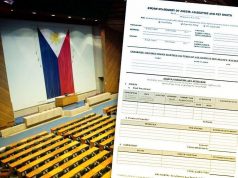Virus infections near 250,000
THE Department of Health (DoH) reported 3,821 coronavirus infections on Thursday, bringing the total to 248,947.
The death toll rose to 4,066 after 80 more patients died, while recoveries increased by 563 to 186,058, it said in a bulletin.
There were 58,823 active cases, 88.3% of which were mild, 8.8% did not show symptoms, 1.2% were severe and 1.7% were critical, DoH said.
Metro Manila had the highest number of cases with 2,079, followed by Rizal with 286, Cavite with 174, Laguna with 168 and Bulacan with 142.
Of the new deaths, 35 came from Metro Manila, 16 from Central Visayas, 13 from the Calabarzon region and six from Western Visayas.
Three deaths were reported from Eastern Visayas, two each from Central Luzon, Northern Mindanao and the Bangsamoro Autonomous Region in Muslim Mindanao (BARMM), and one from the Bicol region.
More than 2.7 million people have been tested for the disease, the agency said.
Meanwhile, eight zones have been identified for COVID-19 vaccine clinical trials under the World Health Organization, Science and Technology Secretary Fortunato de la Peña told an online news briefing.
The areas were picked based on their transmission rate, he said, adding that there would be six zones in Metro Manila, one in the Calabarzon region and one in Cebu.
“Clinical trials in one zone can’t be doubled,” he said in Filipino. “Zones with high virus incidence have been picked.”
Mr. de la Peña said seven foreign companies had signed confidentiality agreements with the Philippine government on COVID-19 vaccine trials.
One of the companies came from Russia, which will soon test the Sputnik 5 vaccine in the Philippines next month. Other companies mentioned were from the United States, China and Australia, he said.
The Science and Technology department was reviewing these deals, Mr. de la Peña said.
DoH on Wednesday said coronavirus infections could surge in the coming days as laboratories play catch-up after it issued stricter rules on test result submissions, according to the agency.
The agency starting on Sept. 1 stopped accepting results without the complete address and phone number of the patient.
Because of this, there were confirmed cases that had not been reported and will come out once the information is complete.
The government earlier said it was looking at enforcing aggressive isolation measures and prohibiting home quarantine for coronavirus patients to bring down the infection rate further.
The government has been setting up more isolation centers for patients that don’t show symptoms and those with mild cases of the virus to contain the virus.
The government on Monday said local coronavirus infections have slowed, while the country’s healthcare system has improved.
The virus reproductive rate stood at 0.94 from four in March, meaning an infected patient can infect one more person, he said.
New cases peaked on Aug. 10 at 6,958 and gradually decreased to 2,592 on Sept. 5. There was also a downtrend in Metro Manila, the Calabarzon region and Central Visayas
Defense Secretary Delfin Lorenzana, the head of the national task force, on Saturday said the Philippines was seeking to flatten the curve by the end of September.
In epidemiology, the idea of slowing a virus spread so that fewer people need to seek treatment at a time is known as flattening the curve.
The curve researchers are talking about refers to the projected number of people who will get infected over time. — Vann Marlo M. Villegas and Gillian M. Cortez



